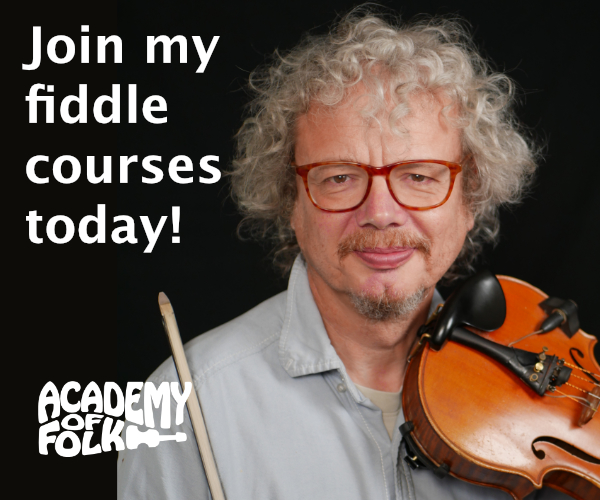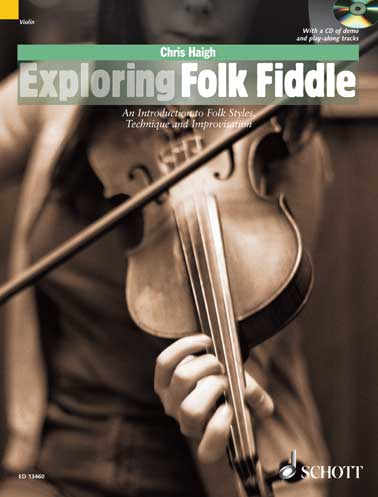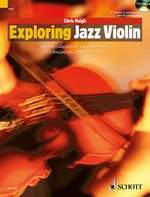
MENU TO FIDDLE STYLES:
--------------------------------
support my work and Become a Patron!
CROSS TUNING/ SCORDATUURA ON THE FIDDLE
Scordatura is the fancy name for it; also known as cross tuning, open tuning or out-of-tuning. It involves changing the relationship between the four strings of the violin, so that you no longer have G,D,A,E, but some other combination. Until very recently I avoided it like the plague, for all sorts of reasons. It upsets the instrument, which likes stability and doesn’t take kindly to such unnatural practices. Gut or synthetic strings wear out more quickly if often tuned up and down, and there’s always a chance of breaking a string if you go up more than about a tone. It’s also harder to keep a fiddle in tune if it’s constantly being retuned. Many fiddlers prefer to use a second, often cheaper fiddle for use in retuning. It breaks the link between the three elements of violin playing; the written music, the finger patterns you use on the fingerboard, and the pitch produced from your fingers. Furthermore it greatly limits what you can play, making rapid key changes impossible; most retunings limit the player to a single key. My thoughts on the matter were summed up by the Scots Victorian fiddler James Scott Skinner. Never one to sit on the fence on such matters, he stated in his Guide to Bowing;
"All this sort of thing is pitiful, and makes the judicious grieve…The violin was never intended for such mutilation. An old idea was to tune the G and D strings to A and E and play reels etc. No artist would descend to such devices for the sake of mere applause. The province of art is to elevate and enliven, but surely never to tend to degeneracy"
VIEW THIS PAGE AS A YOUTUBE VIDEO ON "THE FIDDLE CHANNEL"!
WHY CROSS TUNE ON THE FIDDLE?
So what exactly is the point of cross tuning? In classical music or jazz, it is definitely not a good idea, since key changes are common either within a piece or between pieces, and the subtleties of tone which can be gained are easily lost in the context of an orchestral or band setting. However, there are some styles of traditional music for which cross tuning is essential if you are to achieve an authentic sound. As we will see, the most significant of these are American Old Time, and Norwegian fiddling.
CROSS TUNING FOR DANCE MUSIC
Before the days of amplification, the fiddler had to work hard when playing for dancing. Open string drones were one way of increasing volume. With the fiddle tuned to GDAE, no matter what key you’re playing in, your opportunity to drone on an open string is limited. In the Key of A, for example, the open G string is of little use as a drone. However, if you tune the G up to A, it is far more useful. Not only can you bow it at the same time as fingering melody notes on the D string, it will also ring on its own when not being bowed or fingered, adding further volume and resonance to the fiddle. When played in open tuning, the violin becomes more alive and responsive, almost developing a life of its own. Tunes can achieve a mesmeric quality, allowing endless repetition or variation of a simple theme. Little wonder that Norwegian folklore abounds with tales of fiddlers being possessed whilst playing. In the early days of the violin, scordatura was much more common across a wide range of music. It wasn’t until the 18th C when Bach popularised the “well tempered scale” that modulation to different keys became practical, and from this point on GDAE, which allowed the violinist to play in any key with relative ease, became the norm, and alternative tunings became more of a rarity.
NOTATION IN SCORDATURA
There are two alternative ways to notate in scordatura. One is to write the music “as fingered”. This has the advantage of being easy to read, though at first it can be confusing as what you hear is not what you see. A disadvantage is that music notated in this way cannot be sung or played by another instrument without complicated transposition. The other approach is to write the tune “as heard”. The disadvantage of this is that you have to learn the fingering, and transpose as you’re going on. In modern fiddle books the former has become the dominant approach. The order in which the strings are named is usually from low to high; standard tuning is therefore GDAE, rather than EADG.
CROSS TUNING IN IRISH MUSIC
The chief vehicle for Irish traditional music the world over is today the session, in which the common practice is to change both tune and key with great regularity. As such, the practice of cross tuning is certainly a rarity. However, that is not to say it doesn’t happen at all. The Foxhunter’s Reel is a tune often played in AEAE, for example by Seane Keane. The Donegal fiddler John Doherty is also known for his very convincing bagpipe imitations, using the tuning AAAE to create drones. Listen to his set of reels Piobaire an Chéideath for example. Other fiddlers occasionally using cross tuning include James Kelly, Maeve Donnely, and Caoimhin O'Raghallaigh. Another practice fairly common in Irish fiddling is tuning high or low. This is not strictly scordatura, sine the relationships between the four strings remains the same. It is however a useful technique to alter the tone of the fiddle to suit a particular tune. Tuning low has the effect of bringing out a darker, richer, more resonant sound.
Karen Ryan, for example, on her recent album The Coast Road, plays several tunes with the fiddle tuned down a tone. For some fiddlers the reason for tuning down is to match other instruments, such as the pipes or accordion; Denis Murphy and Julia Clifford, famous Sliabh Lucra players from county Kerry, tuned down to match the model of accordion which was common at the time. Other fiddlers tune up by a semitone or more; this adds brightness, volume and responsiveness to the fiddle. This was particularly important in the dance halls of Ireland before amplification became available, but still occurred in more recent years. Donegal fiddler Tommy Peoples often tuned up; you can hear this for example on his album The Quiet Glen. Frankie Gavin of De Dannan also commonly tunes up a semitone.
SCORDATURA IN SCOTTISH FIDDLE MUSIC
One of the important differences between Irish and Scottish fiddling is that in the latter, there are many published manuscript collections from the 18thC onwards. These give conclusive proof that cross tuning was an important feature of Scottish fiddling from early days. For example, the Caledonian Pocket Companion, from the mid 18thC had tunes in scordatura, as did Niel Gow’s “First Collection of Strathspey Reels”. Scottish music particularly favours scordatura because of the connection with bagpipes and the associated drones, and Shetland fiddlers, such as Aly Bain or Tom Anderson used cross tuning to help achieve the characteristic “ringing strings” sound of Shetland fiddling. AEAE is one of the commonest alternative tunings, ideal for the key of A which is so often found in Scottish tunes; Grove’s Dictionary of Music says “It is frequently employed by Scottish Reel players and in their hands has a singularly rousing effect” Da Auld Foula Reel, as played by Tom Anderson is an excellent example. ADAE is also used for some D tunes. Again to draw from the Shetland repertoire, try the Unst Bridal March- a waltz in A, published in Tom Anderson’s collection.
NORWEGIAN FIDDLE TUNINGS
One of the traditions that has delved most deeply into the possibilities of cross tuning is that of Norway. Scandinavian fiddling has for centuries been closely tied up with myths and legends of devils, trolls and water spirits, and many of the tunings used are imbued with almost magical properties. The Hardanger fiddle, or Hardingfele was developed around 1650, with four or five non-fingered sympathetic strings which lie underneath the fingerboard. The upper strings can be in any of 26 or more possible tunings, with the lower ones tuned to ring freely in whatever key or mode is being used. To complicate matters further, the actual pitch of an individual instrument may vary by over a tone up or down. For example, the most common hardingfele tuning (accounting for around 80% of all tunes) is ADAE, variously known as oppstilt, vanleg stille, or høg bas. However, since fiddlers traditionally play solo, a player may tune the whole fiddle up or down to suit his particular instrument. One outcome of this is that if you listen to a tune where a fiddler claims to be playing in ADAE, what you actually hear may be BEBF#. Among the many other tunings used are ADF#E- called Huldre tuning, after beautiful women who lure unwary males into the underworld, never to return. DDAE Lausbas- (loose bass); well named as the G string is tuned a whole octave below the D. AEAE is halvt-trollstilt (half-troll tuning). When it comes down to it, better to deal with half a troll than a whole troll. One of the most fascinating is AEAC#; (Nackastamning)- this is the devil's own tuning.
Such is the hypnotic nature of this tuning that players can go into a trance and may have to have the fiddle dragged from their hands after hours of playing; alternatively the devil himself may show up at the dance, grab the fiddle and play until the guests are dead from exhaustion. Perhaps the most famous Norwegian tune in AEAC# is Fanitullen, known as the Devil’s Tune.
CROSS TUNING IN OLD TIME FIDDLE
The “old time” Appalachian fiddle tradition is another in which scordatura still plays a very important part. In old time jam sessions fiddlers are happy to stay in a single key and a single tuning for up to an hour. At some point a key change will be suggested, and everyone will retune. If an outsider sees fit to criticise this practice, fiddlers will habitually blame it on banjo players, who apparently find it harder to retune. Banjo players of course blame the fiddlers. Bluegrass players, who pride themselves on their ability to play in any key, of course refuse to retune at all, and sneer at the lot of them.
Tunings in old time music are often named after the best known tunes with which they are associated. AEAC#, which for Norwegians is the devil’s tuning, becomes Calico tuning, after the tune Marcus Martin’s Calico. It is also known as Black Mountain Rag, or Drunken Hiccups tuning. GDAD, used for playing tunes in G, is also called Flatwoods, after the tune of that name. GDGD is sometimes called Sawmill tuning. Listen to the Carolina Chocolate Drops for some excellent tunes in this tuning. Along with AEAE, this is a “symmetrical” tuning. Assuming the melody can be played on the upper two strings, it can be echoed, using the same fingering, an octave down on the lower two strings. AEAD is often called Old Sledge. DDAD, with its very low bottom D drone, is called Dee-Dad, or Dead Man’s tuning. Among the tunes associated with this are Bonaparte’s retreat, Dry and Dusty, and Midnight on the Water. One of the commonest, and simplest (since it just involves raising the G string by a tone) is ADAE. This is used for many D tunes such as Liberty, Soldier’s Joy, Mississippi Sawyer and Arkansas Traveller. Eck Robertson made his famous 1922 recording of Sally Goodin in this tuning. FCGD is another example of what we saw in Irish music, where the whole fiddle is tuned a tone flat, In America this is called Cajun tuning, and its purpose is to make it easier to play with the C diatonic accordion, which is top dog in Cajun music.
WANT TO HELP SUPPORT MY WORK? JOIN ME ON PATREON FOR AS LITTLE AS £4 A MONTH
(This article first appeared in Fiddle On magazine)



